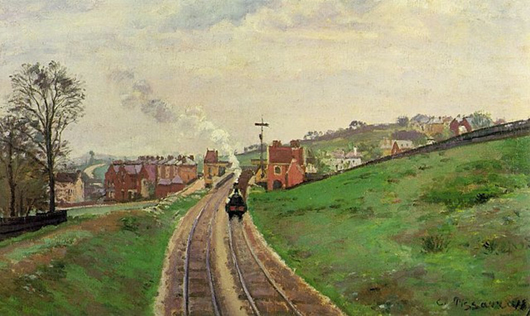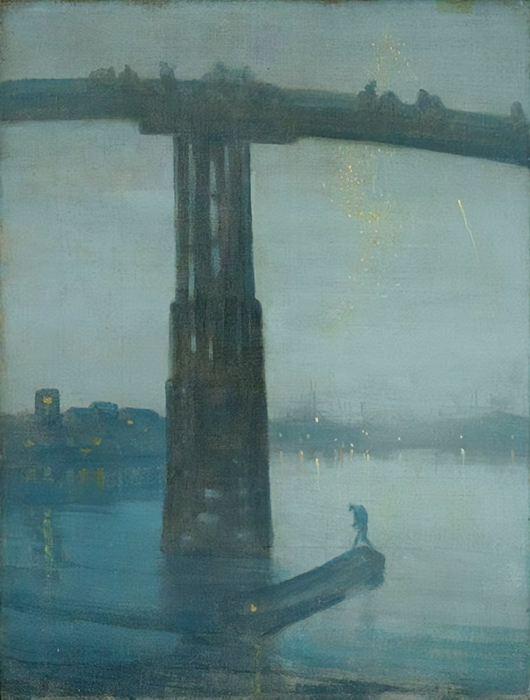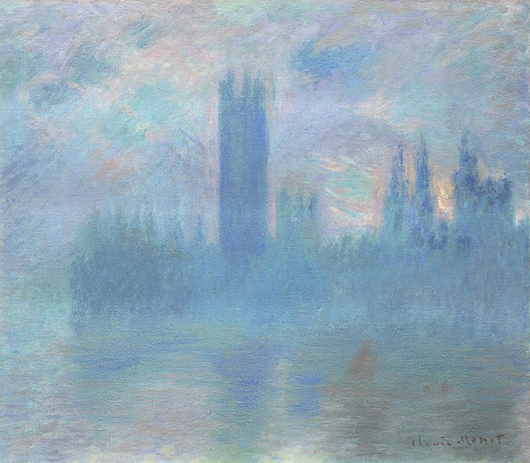1.
camille pissarro (1830–1903)
Lordship Lane Station, Dulwich, 1871

War in Europe appears to have been one of the most common reasons for artists’ relocation to Britain.
Camille Pissarro was no different: When his studio at Louveciennes became surrounded by invading Prussian troops during the War of 1870, the painter moved to England for a year to escape the conflict.
He settled in Norwood (now very much South London, but then just outside the city) where he continued to paint.
It was in London that he fully moved away from his earlier, more academic practice, and, under the influence of Corot, begun to paint what would later be called Impressionist works.
The picture illustrated above depicts Lordship Lane Station in Dulwich at a time when places like Sydenham, Croydon and Norwood were villages connected by rail.
2.
james abbott mcneill whistler, rba (1834–1903)
Nocturne: Blue and Gold – Old Battersea Bridge, c. 1872–75

The American painter James Abbott McNeill Whistler called London his permanent home from 1866 until his death at the start of the 20th Century.
Having made his name with his ambiguously titled figurative works Symphony in White, No. 1 and Arrangement in Grey and Black No. 1 (Whistler’s Mother), the painter took London, and more specifically the Thames, as one of his chief subjects.
Very much inspired by Japanese printmaking and a firm belief that art need not be representative or didactic, Whistler painted a remarkable series of night-time pictures – or nocturnes – of the Thames near his home in Chelsea.
His works from this period verge on abstraction and were presented to the public not as traditional view painting but rather as artistic arrangements, something to which his musically inspired titles allude.
3.
claude monet (1840–1926)
The Houses of Parliament, London, c. 1900-03

Claude Monet, considered the father of Impressionism (and one of the most famous painters ever to have lived), needs no introduction.
For a man so immediately synonymous with French painting, Monet seems to have had a great enthusiasm for London. The artist made several trips to Britain’s capital, the first (like Pissarro) to escape the War of 1870. This was an unhappy time for Monet who, usually so prolific, painted relatively little during this period.
It seems, however, that the idea of London grew upon him in later years, although it would take his son (who was studying in Britain) falling ill to prompt his return.
So taken was he with the Thames (and especially London’s fog) that Monet returned to the city in 1899, 1900 and 1901. His works from these later visits, with London’s atmospheric conditions rendered in visionary colour, are full expressions of Monet’s brand of Impressionism.
To book our latest walk through British Art at Tate Britain gallery in London, please visit our website.
—julija svetlova
Flommist Julija Svetlova is an art historian, freelance researcher and a founder of Neja’s Art Walks, a bespoke provider of art and history-related tours and experiences in London. Julija previously worked as a collection research assistant at the Tate. Copyright © 2023 Julija Svetlova.
PLEASE SUPPORT FLOMM
TIPS + DONATIONS DISCREETLY ACCEPTED












